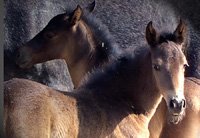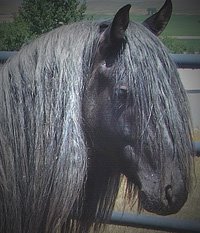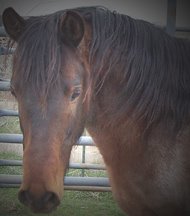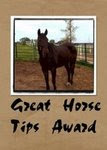 A couple weeks ago, while out riding Aaruba, I met a nice gentleman who lives atop a hill some two miles from In the Night Farm. We talked long enough to learn that we shared a few acquaintances, some training philosophies, and a love of horses. When he mentioned that he's in the process of selecting a stallion for a 2008 breeding to his bay Quarter Horse mare, I invited him to come have a look at Insider and Tuetano.
A couple weeks ago, while out riding Aaruba, I met a nice gentleman who lives atop a hill some two miles from In the Night Farm. We talked long enough to learn that we shared a few acquaintances, some training philosophies, and a love of horses. When he mentioned that he's in the process of selecting a stallion for a 2008 breeding to his bay Quarter Horse mare, I invited him to come have a look at Insider and Tuetano.Three days later, he showed up aboard the bay mare and spent an hour on a casual tour of our place. Having heard positive reports about the Barbs' athleticism and trainability, he was eager to learn more. We discussed the Barb's skeletal structure and conformation, including his short back with exactly five lumbar vertebrae (rather than the usual five-plus-fused-piece or six), round cannon bones (rather than oblong), deeply muscled loins, uphill build, low set tail, and sub-convex profile resulting in large airway capacity.
Though favorably impressed by the stallions' conformation and demeanor, my neighbor repeatedly expressed surprise at the small size of the Barbs, which generally fall between 13.2 and 15 hands and mature slowly, often not reaching their full height until age five or older. He seemed to think that horses with a reputation for toughness ought to be tall and bulky, and his reaction to Insider, who stands just 13.3, was typical: "Well, if I wanted to breed for a kids' horse..." I hear it all the time -- but only from people who haven't seen the big horse inside the little body!
 Don't get me wrong. I think my neighbor is a pretty good horseman. He is, however, yet another victim of the "bigger is better" epidemic that has swept America. The epidemic isn't restricted to fast food menus and SUV's -- it affects our horses as well.
Don't get me wrong. I think my neighbor is a pretty good horseman. He is, however, yet another victim of the "bigger is better" epidemic that has swept America. The epidemic isn't restricted to fast food menus and SUV's -- it affects our horses as well.I prefer the ancient, light breeds, particularly the Barb and Arabian. Though small and slow-growing, they can carry a relatively high weight for their size, not least because they're hauling around less of their own bulk. Those bred for performance rather than the "halter look" tend to be athletic, with a lot of bone and large hooves relative to their size. They rarely suffer the hoof, joint, and back problems so common among today's Quarter Horses and Warmbloods. Many factors are at play in such deficiencies -- the futurity/racing trend of starting massive but skeletally immature two-year-olds under saddle, breeding for appearence rather than performance, and the practice of hastening growth by means of selective breeding and excessive nutrition, just to name a few.
Surely nature never intended near-adult weight to hang on a baby equine's frame. Nevertheless, my neighbor was shocked to see my 20-month-old Barbs (including CJ, whose photos accompany this post) at the approximate height of, and lower weight than, a Quarter Horse yearling. Imagine his incredulous tone. "These are two-year-olds?"
 "Five years from now," I wanted to say, "let's test your 2006 foals against mine. You choose the discipline -- reining, cutting, endurance, jumping, polo, dressage -- and you'll see what these itty-bitty Barbs can do...barefoot and on a diet of hay alone."
"Five years from now," I wanted to say, "let's test your 2006 foals against mine. You choose the discipline -- reining, cutting, endurance, jumping, polo, dressage -- and you'll see what these itty-bitty Barbs can do...barefoot and on a diet of hay alone."I refrained, however. My neighbor said he'd consider his options for the bay mare, and I waved him off with a smile and a promise that a half-Barb will be the best horse he's ever had -- even if it is the smallest.









2 comments:
OK, first the pictures, great googly moogly, look at the way CJ is already engaging his back. I'm continually amazed at how well these horses use their entire bodies to move, unlike a lot of horses today, that have to be taught to use much of their body. It's simply amazing, and beautiful.
Secondly...well, I'm not surprised that the QH mare guy didn't get the size thing. It's sad, but not surprising. Now granted, I like big horses, a hold over from my childhood, and loving Drafts, but I like horses that are big for a good reason (like draft crosses, or Friesians), and not ones that have been bred out of all recognition from their original form in the persuit of big.
I have a lovely example. Growing up, one of my Mom's friends brought her horses up from California to board with us for a while. She had a QH stallion, a very elderly QH stallion. This horse resembled today's QH's about as much as an Andalusion would. He was very small, and compact. He had a bigger head proportionally, and it was rangy looking (not dainty). He had very sturdy legs, with very solid bone, and bigger hooves proportionally. He did NOT have the huge QH butt, and he was very, very smart. He was exactly what the breed was originally supposed to be, a perfect little cow pony, with intelligence, endurance and hardiness (a lot like the Barbs).
Maybe if the QH mare guy knew what his breed was originally like, he would get over the height thing.
Agreed on all counts. The foundation Quarter Horses did, in fact, have a great deal of Barb blood. It isn't uncommon for people to assume my Barbs are foundation Quarter Horses, though upon being corrected, they acknowledge that the "Spanish look" had been a source of puzzlement.
Regarding large horses -- I think you hit the nail on the head. There's nothing wrong with tall or heavy horses in their intended "original" type. The problems arise when you start crossing light and heavy body types in the hope of creating something with the positive aspects of both. Doing so may produce a some nice foals, but the majority of the offspring is likely to exhibit a peculiar, and undesirable, hodgepodge of conformational traits and resultant soundness issues.
Post a Comment